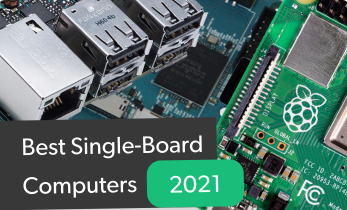Best Microcontrollers for All Uses
Microcontrollers such as Arduino boards are incredibly useful for a variety of different projects. Such integrated circuit (IC) systems serve as the foundation of a variety of embedded devices. While many microcontroller units (MCUs) feature similarities, there are differentiating factors. Looking for the right MCU for your needs? Check out the best microcontrollers for all uses!
What is a Microcontroller and How Does it Work?
A microcontroller is an integrated circuit engineered to complete various tasks in embedded systems. Most MCUs feature components such as a processor, memory, and input/output (I/O) onboard. Data is transmitted to and from any connected I/O peripherals such that the microcontroller controls a specific function. Information is temporarily stored on the microcontroller itself which, in turn, is used to power various connected components. This could be as simple as blinking an LED at a certain interval or something more complex such as taking readings from moisture sensors to activate a motor in part of an automatic plant watering irrigation system.
The way a microcontroller works is such that code is written and uploaded to the onboard memory. Then, that code executes various commands so data is sent to and from connected components. Microcontrollers and single-board computers can accomplish some of the same tasks, but with notable differences. While a SBC requires an operating system running on the device itself, and then programs running on top of the OS, an MCU simply has a program uploaded to it. As such, it's a device that accomplishes one task, even if that task has multiple steps involved like reading one sensor, and performing a follow-up action with another component based on the data received.
Best Microcontroller for Beginners - Grove Beginner Kit
The SeeedStudio Grove Beginner Kit (our review) is hands-down the best microcontroller for beginners. Although, to refer to the Grove Starter Kit for Arduino as simply an MCU is a bit misleading. SeeedStudio's Grove is an Arduino Uno R3 compatible microcontroller that's connected to 10 different sensors and components. Onboard, you'll find devices such as an LED, buzzer, button, OLED display, temperature and humidity sensor, 3-axis accelerometer, air pressure sensor, light sensor, rotary potentiometer, plus a sound sensor.
Because all of the add-ons come attached via PCBs, you don't even need to solder or plug in any wires. What's more, the Grove Beginner Kit for Arduino uses the Grove system which consists of DuPont connectors for simple plug-and-play operation. You can easily break out the included sensors and Arduino components, then hook up those using Grove wires. And the Grove Starter Kit is scalable, boasting compatibility with SeeedStudio's entire array of Grove accessories. While the Grove Arduino Beginner kit is excellent for newcomers to the Arduino platform, it's great for advanced and intermediate users as well. Since it's so simple to use, it's a quick prototyping platform. Additionally, with 10 pre-wired Grove modules, it's cost-effective. Cheap, user-friendly, and with a bevy of included accessories, the Grove Beginner Kit for Arduino is the top Arduino for beginners.
Best for: Beginners, intermediate users, and advanced DIYers alike
Pros:
- Easy to use
- No soldering or wiring required
- 10-pre-wired Grove modules included (temperature and humidity sensor, 3-axis accelerometer, air pressure sensor, light sensor, rotary potentiometer, sound sensor, LED, buzzer, button, and OLED display)
- Arduino UNO compatible microcontroller
- 12 included tutorials
- Affordable
- Scalable - compatible with Grove accessories
- Works with the Arduino IDE
Cons:
- None
Best Arduino Microcontroller Board for Most Users - Arduino Uno R3

The Arduino Uno Rev 3 is the best overall microcontroller for most users. Compatible with the Arduino Integrated Development Environment, the Arduino Uno R3 is incredibly well documented. Based on the ATmega328 microcontroller, the Uno Rev 3 sports 32KB of flash memory, 2KB SRAM, 1KB EEPROM, and a 16Mhz clock speed, Coupled with 14 digital input/output (I/O) pins and a USB port, the Arduino UNO R3 is a very capable microcontroller. You'll find an official version from Arduino as well as a boatload of Arduino clones. You can snag the Arduino Uno Rev 3 as a standalone MCU or as part of a starter kit. No matter what project you have in mind, the Arduino Uno R3 should work just fine. From simple beginner-friendly tasks such as blinking an LED to building a robot, the Uno Rev 3 is up to virtually anything you throw at it. There's a reason the Arduino Uno R3 is the most popular microcontroller on the market - it's well-documented, easy to use, and suitable for makers of all skill levels.
Best for: Most users
Pros:
- Based on the ATmega328 microcontroller
- 32KB flash memory, 2KB SRAM, 1KB EEPROM
- 16Mhz clock speed
- 14 digital I/O pins
- Compatible with the Arduino IDE
- Works with Arduino shields and hats
Cons:
- No accessories included with the standalone board
Best Microcontroller for Industrial Applications - BeagleBone Black

The BeagleBone Black is one of the top microcontrollers you can find. Powered by an Octavo Systems OSD3358 1GHz ARM Cortex-A8 processor, the BeagleBone Black is mated to 512MB of DDR3 RAM. Built-in I/O provides ample connectivity for virtually any Internet of Things project. There are dual 46-pin GPIO (general purpose input/output) headers, USB, HDMI, and more. The BeagleBone Black Wireless adds Wi-Fi for wire-free networking. Capable of running Linux distributions (distros) such as Debian. Ultimately, it's a great board for industrial applications.
Best for: Intermediate and advanced makers, industrial/embedded applications
Pros:
- 4GB flash memory
- 1GHz clock speed
- 512MB DDR3 RAM
- OSD3358 1GHz ARM Cortex-A8 processor
- Affordable
Cons:
- Not the most user-friendly
- The processor isn't as strong as the Raspberry Pi 4 or even Raspberry Pi 3 B+
Best Microcontroller for Wearables - Adafruit Gemma

Because of their small form factors, low power draw, and excellent connectivity, microcontrollers can integrate into wearable projects such as cosplay outfits. And the pint-sized Adafruit Gemma functions extremely well for wearable tech. The tiny Gemma M0 Mini is a coin-sized and -shaped MCU that even boasts alligator-clip sew pads built into its outer ring. As such, the Gemma M0 may easily be attached to clothing. Powered by an ATtiny85, the Gemma M0 might be small but it doesn't skimp on processing power. You can run CircuitPython directly on the Adafruit Gemma M0, plus there's Arduino IDE compatibility.
Best for: Beginners, intermediate, and advanced users. Wearable tech/cosplay
Pros:
- Small, coin-sized microcontroller
- Built-in alligator-clip sew pads for integrating into clothing
- Excellent for wearables
- Runs CircuitPython
- Arduino IDE compatibility
- ATtiny85-based ATSAMD21E18
- Affordable
Cons:
- Not the most powerful processor
- Limited connectivity
Best Microcontroller for Robotics - BeagleBone Blue

The BeagleBone Blue is a small form-factor maker board that concentrates on robotics. Powered by an Octavo OSD3358 microprocessor, the BeagleBone Blue packs a ton of sensors including Wi-Fi, Bluetooth, state-of-change LEDs, a barometer, and headers for servos as well as DC motors or encoders. The AM335x 1GHz ARM Cortex-A8 processor is paired with 512MB of DDR3 RAM and a 4GB eMMC flash storage module. With decent specs, the BeagleBone Blue is the best microcontroller for robotics. When compared to single-board computers like the Raspberry Pi 4, the BeagleBone Blue lacks the processing power of many modern dev boards. But for robotics and less computing-intensive tasks, the BeagleBone Blue rocks.
Best for: Intermediate and advanced users, robotics projects
Pros:
- AM335x 1GHz ARM Cortex-A8 processor
- Octavo OSD3358 microprocessor
- Excellent I/O (Wi-Fi, Bluetooth, a barometer, state-of-charge LEDs for a 2-cell LiPo, connection headers for up to 4 DC motors and encoders or 8 servos, etc.)
- Affordable
- 512MB DDR3 RAM, 4GB eMMC flash storage
- Fantastic for robotics
Cons:
- Not the most powerful processor
Best ESP32 Microcontroller - Adafruit Huzzah32 Feather Board

The ESP32 platform offers an upgrade over ESP8266. If you're looking for an ESP32 microcontroller, the Adafruit Huzzah32 is one of the top MCUs on the market. It's an ESP32-based Feather built on top of the WROOM32 module. Standard features such as a built-in USB-to-serial converter, Li-Ion Polymer charger, GPIOs, and an automatic bootloader make the Adafruit Huzzah32 ESP32 Feather board a solid microcontroller. Boasting Bluetooth low energy (BLE) and Wi-Fi, the dual-core ESP32 Feather Huzzah32 is a good device for Internet of Things projects.
Best for: Intermediate and advanced users, IoT projects
Pros:
- ESP32-based microcontroller
- Small form factor
- GPIOs
- BLE and Wi-Fi
- 4MB SPI Flash memory
- Automatic bootloader
- USB-to-serial converter
Cons:
- Not very user-friendly, developer-oriented
Best ESP8266 Microcontroller - Adafruit Feather Huzzah ESP8266

The ESP8266 Wi-Fi system-on-a-chip (SoC) features a bunch of connectors and a 32-bit processor. Capable of being programmed directly with the Arduino IDE, this microcontroller is a good option for low-cost wireless microchips. The Adafruit Feather Huzzah ESP8266 is an awesome ESP8266-based MCU. Small, portable, and with a built-in USB as well as battery charging capability, the Adafruit Feather Huzzah ESP8266 sports a microcontroller clocked at 80MHz. There's a USB-serial chip, 3.7V Lithium polymer battery connector, and more. Like its Adafruit Feather ESP32 variant, the Feather Huzzah ESP8266 isn't the most user-friendly, but for seasoned makers, it's a good option. You might also consider the Nodemcu V2 ESP8266 dev kit.
Best for: Intermediate and advanced DIYers
Pros:
- ESP8266-based
- Small
- USB and battery charging
- 80MHz clock speed
- USB-to-serial chip
- 3.7V Lithium polymer battery connector
Cons:
- Not the most user-friendly platform
Which microcontroller is best for you?
Take a look at our updated video which covers PIC Microcontrollers, AVR Microcontrollers, STM8 Microcontrollers, STM32, and RP2040!
Best Microcontrollers for All Uses - Top Microcontrollers for Makers and DIYers
Overall, there are loads of microcontrollers for a variety of purposes. Beginners should seek out the SeeedStudio Grove Beginner Kit for Arduino or Arduino Uno Rev 3. The Uno R3 is a good all-around MCU and the most popular microcontroller on the planet. For seasoned makers, ESP32 and ESP8266 platforms like the Adafruit Huzzah Feather work well. And tiny MCUs such as the Adafruit Gemma M0 integrate into wearables and cosplay easily. If you're working with IoT or robotics, BeagleBone's Black and Blue boards are nifty options.
Your turn: Which microcontrollers do you recommend?















































Leave your feedback...